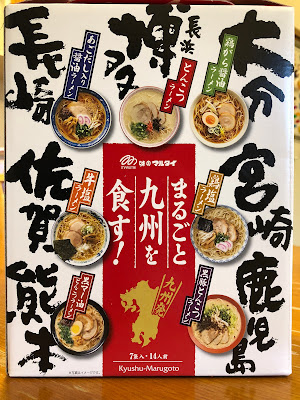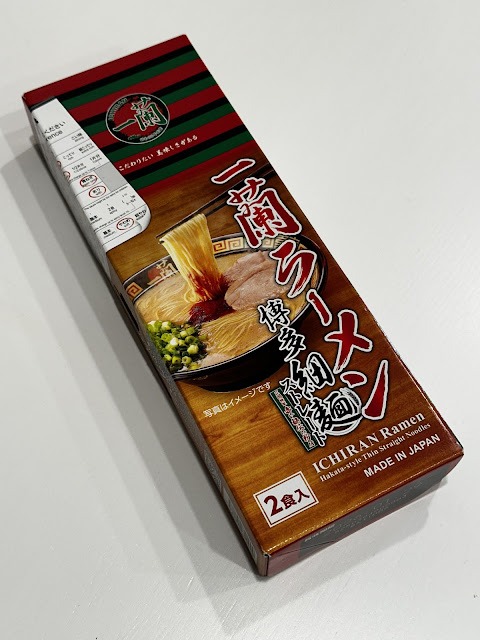Maruchan is a brand of Toyo Suisan and they make a lot of instant noodles amongst other products. Some of their more popular instant noodles are their Red Fox udon bowls with fried tofu and their Green Tanuki tempura soba bowls. They even run commercials having fun with the two types of noodles. I found four of the better known varieties of their Red Fox bowls at the supermarket and thought it would be fun to compare their flavours. This review will taste the Red Fox (Kitsune) Udon bowls for East Japan, West Japan, Kansai, and Hokkaido.

These red fox bowls all have the same block of udon noodles, a different soup powder sachet, a sachet of togarashi pepper to add some zip if needed, a large piece of sweet and savoury fried tofu, some fish cake, and fluffy egg balls. The main difference seems to be in the soup base, but it is possible that the fried tofu could be a little different too, but I'm not sure. These are called kitsune (red fox) noodles as foxes in legend like to eat fried tofu. Offerings of fried tofu are sometimes found for fox guardians at shrines.
Maruchan Red Kitsune Udon East
This udon soup is the classic flavour that I am used to for a udon broth. It is a flavourful soup that is made with katsuoboshi (dried/smoked bonito), kelp, and fish with dark soy sauce. Often a difference in flavour depends on the type of soy sauce (dark versus light) and the concentration of various ingredients. These soups taste really good in part due to the concentration of natural MSG from the kelp and bonito.
 |
| Top view of the standard lid with pink identifying the ingredients used in the soup. |
 |
| Another view. |
 |
| The ingredients. This will change slightly from bowl to bowl based on the ingredients used and their concentrations. So the ingredients will shift in order. |
 |
| Opened bowl showing the soup powder sachet and the togarashi pepper. You add the soup base before fill with boiling water up to the fill line. Prep directions are the same for all of these. |
 |
| The final prepared product after letting it sit in boiling water for 5 minutes. |
This udon soup had a mild, but still rich flavour profile (from umami, not fats) that was dashi-like and had a sweetness. It was a pleasant soup and would be a very nice way to start your morning or warm you up on a cold day. You could taste the smoky flavour of the katsuoboshi in it. This soup is quite similar to the West Japan in many ways. It is mellow and it seemed saltier near the end even though everything was mixed well. The fried tofu always rehydrates nicely as it is quite porous and it has a chewy bite to it that is spongy in a good way. The tofu is sweet and savoury and the noodles are your standard flat udon instant noodles with a nice bite and chew to them.
Maruchan Red Kitsune Udon West
This udon soup was full of flavour yet mild. This soup uses katsuoboshi, kelp, dried sardines, and light soy sauce as ingredients.
 |
| Lid of the bowl with the ingredients for the soup shown in the blue area. |
 |
| Another view. |
 |
| The ingredients listing. This will change slightly per type of bowl. |
 |
| The contents of the bowl. |
 |
| You can see the fluffy egg balls and the big piece of tofu. The big piece of tofu is one of the best things about these bowls. |
This udon soup was not as salty to the taste buds even though light soy sauce was used - must have used less of it. There was a strong seafood aroma to the soup - probably from the dried sardines. The broth still had that classic dashi flavour profile with a definite katsuoboshi taste in it. The tofu seemed sweeter in this one, but I'm not sure.
Maruchan Red Kitsune Udon Kansai
This is a Kansai style soup from the southern part of Honshu (Seto Inland Sea area, Hiroshima). Key ingredients in the soup are katsuoboshi, kelp, mackeral, another fish that I think is whitefish, some other ingredients, and light soy sauce. Seems to be more complex than the east and west versions.
 |
| Lid of the bowl and the key ingredients of the soup are in the yellow area. |
 |
| Another view. |
 |
| Preparation directions. Same for all the bowls. |
 |
| Nutritional information. |
 |
| Note how the ingredients do shift around a bit for the different bowls. |
 |
| The opened bowl with all the contents shown. |
 |
| The prepared noodle soup ready to eat. |
There is a definite katsuoboshi smell / fish smell to this broth. Unlike the east and west versions this had a stronger salt note in the flavour profile. It smells like dashi though and the soup mellows a bit as you drink more of it. I usually drink more of the soup from these udon soups. The egg balls were a nice touch along with the standard sliced of fish cake. The sweet soy marinated tofu was tasty with a nice chew with a definite break, and spongy texture. The tofu really soaks up the broth and it can be quite hot to the bite! The wide and flat udon noodles had a good chew to them and a clean break.
Maruchan Red Kitsune Udon Hokkaido
This udon soup is actually manufactured in their Hokkaido plant - nice touch for authenticity. It uses katsuoboshi and Rishiri kelp as the key ingredients to create a mellow and sweeter soup.
 |
| Lid showing the two key ingredients in the green area. |
 |
| Another view. |
 |
| Preparation directions. |
 |
| Nutritional information. |
 |
| Ingredients again. |
 |
| The contents. You can see how big the piece of tofu is. These soups really are bargain when you talk about contents due to the large piece of dehydrated tofu. |
 |
| The prepared and finished product. |
 |
| Closeup of the noodles and tofu. The egg balls almost melt in your mouth! |
This soup was quite tasty. It definitely was mellower than the other soups tried and it still had some good flavour to the dashi. It wasn't as salty and it seemed to me that is had a deeper flavour profile to the broth. There was still some saltiness for sure, but more like an aftertaste on the tongue. I was also wondering if the tofu was sweeter than normal too or if it was my imagination. I'm sure the tofu tastes a little different based on the different kinds of soup it is in too.
Conclusion
It is pretty hard to pick a favourite out of these udon soups. They all really taste pretty good. My standard East Japan version is always good, but the Hokkaido version might have been the most different, with the strongest tasting one from the Kansai region. I think it comes down to what you are used to and you really can't go wrong with any of these! There are also many more varieties to try too, so I've put a link to their website below.
商品情報 | 東洋水産株式会社 (maruchan.co.jp)
Other Japanese Pop Culture Articles
Follow me on Twitter or Instagram at @Tostzilla or my feedburner.





































Comments
Post a Comment